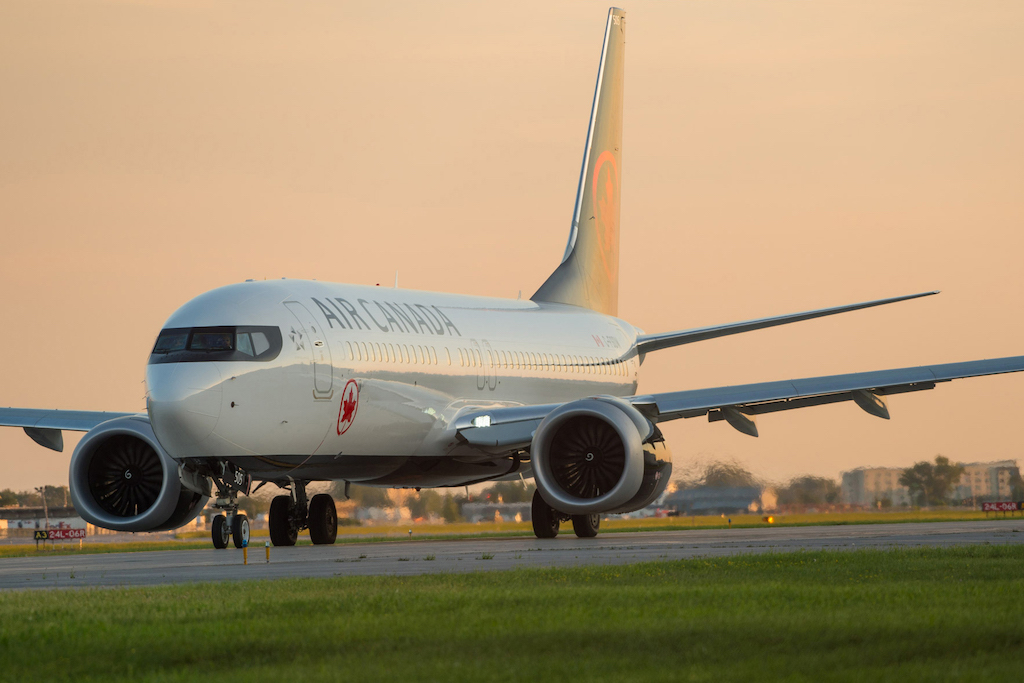Photo credit: Air Canada 737 Max Air Canada / Courtesy of Air Canada
Cargo was a lifeline for Air Canada during the pandemic as passenger operations were largely sidelined by Canada’s strict coronavirus restrictions, and it will continue to play an important role for the carrier as it climbs out of the crisis. The carrier has operated more than 7,500 cargo-only flights since last March, including more than 2,000 just in the first quarter of this year.
Air Canada is adding two dedicated Boeing 767 freighters acquired from ATSG to its fleet by the end of the year. In addition, the carrier converted five Boeing 777-300ERs and four Airbus A330-300s temporarily to freighters by removing seats from the passenger cabins. These nine converted aircraft are expected to stay in the fleet at least until the end of the year, Chief Commercial Officer Lucy Guillemette told analysts during Air Canada’s first-quarter 2021 earnings call. As passenger service returns, the carrier will benefit from increasing belly-hold freight capacity as well, she added.
In addition to international air freight, Air Canada is building an e-commerce logistics business, Guillemette said. The carrier is working with local retailers for domestic package shipments around Canada. This is part of the carrier’s strategy to “capture unique revenue opportunities,” she said.
Unique or not, Air Canada’s cargo strategy is working. The carrier earned CAD$281 million ($231 million) in cargo revenue in the first quarter, or CAD$132 million more than in the same period last year — an 89 percent increase. Cargo yields rose 130 percent, even though cargo traffic was down 18 percent from 2020. Air Canada reported the strongest freight demand on transpacific and transatlantic routes.
The passenger side was another story. Canada has among the strictest Covid-19 travel restrictions in the world, requiring all incoming passengers to provide a negative test result at departure, a test on arrival in Canada, and a mandatory quarantine. Inter-provincial restrictions also have limited domestic travel. Canada needs a “modified and more relevant approach to testing and quarantine,” CEO Michael Rousseau said.
“The government must act, because air transport is a central pillar in the nation’s infrastructure,” Rousseau said, adding “a multicultural, trading country like Canada needs a healthy aviation sector.” Air Canada alone was responsible for 2 percent of Canada’s GDP before the pandemic and directly employed 40,000 people, he said. Canada has given no timeline for when restrictions may be relaxed. The government had come under criticism for an early slow vaccine roll out and is just emerging from a third wave of the disease.
Air Canada is keeping a keen eye on how passenger demand is accelerating in the U.S. and other countries that have vaccinated more of their population than Canada has. And what it sees is encouraging. The carrier believes Canadian demand will start to return in the second quarter and will accelerate in the third and fourth quarters. Already, Air Canada reports stronger than expected bookings for beach destinations in the fourth quarter. U.S. routes are expected to return quickly after Canada opens its southern border. European routes could start to recover in September. Travel to Asia is expected to recover last, with no timeline for when that may occur.
Leisure and visiting friends and relatives (VFR) traffic will lead the recovery, with the latter expected to fuel transatlantic demand. As with many other carriers, premium leisure travel will be a more important segment for Air Canada, especially as business travel remains in the doldrums.
Based on discussions with its corporate clients, Air Canada expects business travel to start picking up by September at the earliest. Domestic Canada business travel will be the first to restart, followed by transborder to the U.S., and transatlantic by the end of the year or the beginning of next year. Much of this timeline depends on companies bringing workers back to offices and international travel restrictions easing, Guillemette said.
Air Canada did not furlough pilots during the crisis and has ensured its pilots remained up-to-date. This gives the carrier the ability to add capacity rapidly when demand starts to return. Furloughed flight attendants can be brought back and returned to the flight line after a few days of training, Rousseau said. The carrier also can quickly bring its mothballed jets back into service. In the meantime, Air Canada’s load factors averaged just under 44 percent in the first quarter, so it can meet rising demand with the capacity it already flies.
Air Canada’s first-quarter capacity was down 82 percent from last year and 84 percent from 2019. Revenues fell 80 percent from 2020 to CAD$729 million ($600 million), resulting in a loss of CAD$1 billion. Daily cash burn in the quarter was CAD $14 million, lower than the previously forecast CAD$15-17 million. Second-quarter cash burn is expected to be CAD$15-17 million per day, and Second-quarter capacity is expected to be double last years, but 84 percent lower than in 2019.
In the quarter, Air Canada consolidated all its regional flying with Jazz. It also ended merger talks with Air Transat. Last month, the Canadian government extended a $5 billion package of loans and aid to Air Canada and is in talks with the country’s other carriers for similar funding.
Special Offer: Choose From Quarterly or Annual Subscription Plans
{{monthly_count}} of {{monthly_limit}} free stories left to read
SubscribeAlready a member? Sign in here
You Need an Airline Weekly Susbcription to Read This Story
Your story count resets on {{monthly_reset}}
Already a member? Sign in here
